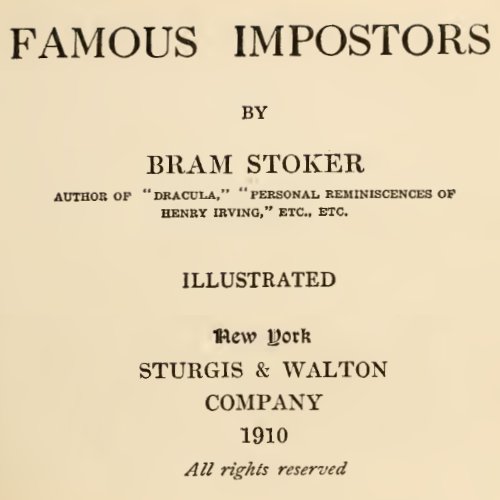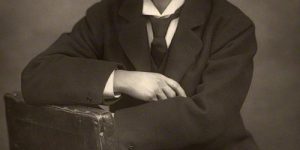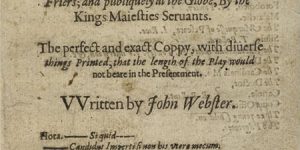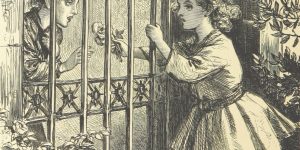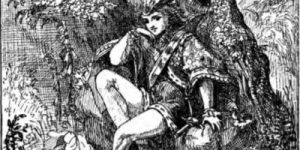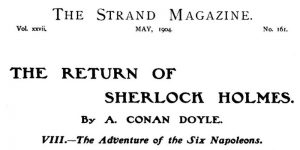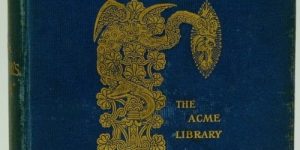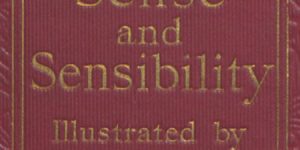The Moon Hoax : Famous Impostors by Bram Stoker
Famous Impostors : Hoaxes The Moon Hoax
by
Bram Stoker
The Moon Hoax
One of the most stupendous hoaxes, and one foisted on the credulity of the public with the most complete success, was the famous Moon Hoax which was published in the pages of the New York Sun in 1835. It purported to be an account of the great astronomical discoveries of Sir John Herschel at the Cape of Good Hope, through the medium of a mighty telescope, a single lens of which weighed nearly seven tons. It was stated to be reproduced from the Supplement to the Edinburgh Journal of Science, though as a matter of fact, the Journal had then been defunct some years. In graphic language, and with a wealth of picturesque detail, the wonders of the Moon as revealed to the great astronomer and his assistants were set forth. A great inland sea was observed, and “fairer shores never angel coasted on a tour of pleasure.” The beach was “of brilliant white sand, girt with wild castellated rocks apparently of green marble, varied at chasms, occurring every two hundred feet, with grotesque blocks of chalk or gypsum, and feathered and festooned at the summit with the clustering foliage of unknown trees.” There were hills of amethysts “of a diluted claret colour”; mountains fringed with virgin gold; herds of brown quadrupeds resembling diminutive bison fitted with a sort of “hairy veil” to protect their eyes from the extremes of light and darkness; strange monsters—a combination of unicorn and goat; pelicans, cranes, strange amphibious creatures, and a remarkable biped beaver. The last was said to resemble the beaver of the earth excepting that it had no tail and walked only upon its two feet. It carried its young in its arms like a human-being, and its huts were constructed better and higher than those of many savage tribes; and, from the smoke, there was no doubt it was acquainted with the use of fire. Another remarkable animal observed, was described as having an amazingly long neck, a head like a sheep, bearing two spiral horns, a body like a deer, but with its fore-legs disproportionately long as also its tail which was very bushy and of a snowy whiteness, curling high over its rump and hanging two or three feet by its side.
But even these marvels fade into insignificance compared with the discovery of the lunarian men “four feet in height, covered, except on the face, with short and glossy copper-coloured hair, with wings composed of a thin membrane.” “In general symmetry they were infinitely superior to the orang-outang”—which statement could hardly have been regarded as complimentary; and, though described as “doubtless innocent and happy creatures,” the praise was rather discounted by the mention that some of their amusements would “but ill comport with our terrestrial notions of decorum.” In the “Vale of the Triads,” with beautiful temples built of polished sapphire, a superior race of the punariant were found, “eminently happy and even polite,” eating gourds and red cucumbers; and further afield yet another race of the vespertilio-homo, or man-bat, were seen through the wonderful telescope of “infinitely greater personal beauty … scarcely less lovely than the general representation of angels.”
Such were a few of the marvels told of in the Moon story; and, though one may laugh at them as they stand, shorn of their clever verbiage and quasi-scientific detail, at the time of publication they were seriously accepted, for the popular mind, even among the educated classes, was then imbued with the fanciful anticipators of vast lunar discoveries heralded in the astronomical writings of Thomas Dick, LL.D., of the Union College of New York. Scarcely anything could have been brought forward too extravagant for the general credulity on the subject then prevailing; and this well-timed satire, “out-heroding Herod” in its imaginative creations, supplied to satiety the morbid appetite for scientific wonders then raging. By its plausible display of scientific erudition it successfully duped, with few exceptions, the whole civilised world.
At the time, the hoax was very generally attributed to a French astronomer, M. Nicollet, a legitimist who fled to America in 1830. He was said to have written it with the twofold object of raising the wind, and of “taking in” Arago, a rival astronomer. But its real author was subsequently found to be Richard Adams Locke, who declared that his original intention was to satirise the extravagances of Dick’s writings, and to make certain suggestions which he had some diffidence in putting forward seriously. Whatever may have been his object, the work, as a hit, was unrivalled. For months the press of America and Europe teemed with the subject; the account was printed and published in many languages and superbly illustrated. But, finally, Sir John Herschel’s signed denial gave the mad story its quietus.
Famous Impostors
Chapter I. Pretenders
A. Perkin Warbeck
B. The Hidden King
C. Stephan Mali
D. The False Dauphins
E. Princess Olive
Chapter II. Practitioners of Magic
A. Paracelsus
B. Cagliostro
C. Mesmer
Chapter III.
The Wandering Jew
Chapter IV.
John Law
Chapter V. Witchcraft and Clairvoyance
A. Witches
B. Doctor Dee
C. La Voisin
D. Sir Edward Kelley
E. Mother Damnable
F. Matthew Hopkins
Chapter VI.
Arthur Orton (Tichborne claimant)
Chapter VII. Women as Men
A. The Motive for Disguise
B. Hannah Snell
C. La Maupin
D. Mary East
Chapter VIII. Hoaxes, etc.
A. Two London Hoaxes
B. The Cat Hoax
C. The Military Review
D. The Toll-Gate
E. The Marriage Hoax
F. Buried Treasure
G. Dean Swift’s Hoax
H. Hoaxed Burglars
I. Bogus Sausages
J. The Moon Hoax
Chapter IX.
Chevalier d’Eon
Chapter X.
The Bisley Boy

